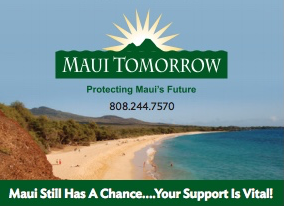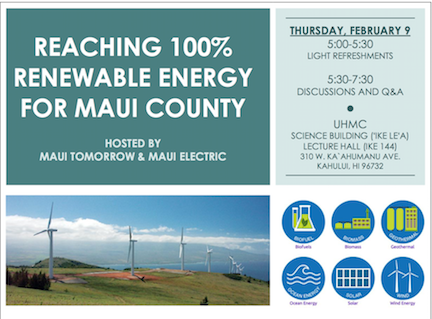SB 2785 (proposed undersea high voltage transmission cable) has a hearing on Thursday, February 2, 2012 at 2:55 p.m. at the Capitol in Room 225.
Easy to file Internet comments can be submitted at http://www.capitol.hawaii.gov/submittestimony.aspx Testimony can be uploaded at the same site. Hearing Notice SB 2785
The Committee on Energy and Environment (Chair Gabbard) and the Committee on Commerce and Consumer Protection (Chair Baker) are hearing the bill.
Interesting Points: Only proposed high voltage line thru marine sanctuary in U.S. Route includes the South Moloka`i Reef: the longest fringing reef north of Australia; Route includes the Penguin Bank: a 20 miles long and 7 miles wide, 200 foot deep, plateau surrounded by 2000 foot deep water; Route includes the Whale Sanctuary. National Oceanic and Atmospheric Administration (NOAA) National Marine Fisheries Service (NMFS) re Big Wind Programmatic EISPN: “The impacts of the proposed power cable on protected marine species is a concern for our agency, both from short- and long-term impacts of the cable installation, as well as the potential long-term effects of high-level electromagnetic fields emanating from the cable on the seafloor. …The acoustic impacts could also disrupt the foraging behaviors of the Hawaiian monk seal, a critically endangered species whoes populating numbers are still declining…PRD is concrned about the potential for long-term impacts from electromagnetic fields. These impacts are not well understood and it is unclear exactly what effects these fields may have on protected marine species, their prey, and on their predators such as sharks. …the effects of high electromagnetic fields in the marine environment should warrant a precautionary approach until further studies can answer these questions.” (http://www.hirepeis.com/documents/scoping-comments/agencies/DOC-NOAA.pdf) United States Fish and Wildlife Service (USF&W) re Big Wind Programmatic EISPN: “Important fish and wildlife resources occur throughout the proposed project areas, including the coastal, wetland, stream and marine habitats. …The Service recommends that particular attention be given in the DPEIS to construction, operation and maintenance related impacts on endangered and threatened species, migratory birds, wetlands, streams, coral reefs, fisheries, and rare native species and habitats. …The DPEIS should include an analysis of potential impacts to affected wetland, stream and coral reef-related ecological functions. …This project has the potential to have direct and indirect effects to many listed species on various islands. …The Service considers the spread of non-native invasive species to be a major threat” (http://www.hirepeis.com/documents/scoping-comments/agencies/DOI-F&W.pdf) United States Environmental Protection Agency (EPA) re Big Wind Programmatic EISPN: “We recommend analysis of additional alternatives as early as possible” (http://www.hirepeis.com/documents/scoping-comments/agencies/EPA_comments.pdf)
Alternatives (From Henry Curtis): The greatest community buy-in is for solar, especially roof top solar. Sempra a Fortune 500 company, has proposed a Pearl Harbor photovoltaic system that would supply about 5% of O`ahu’s electricity needs located on about 0.7% of O`ahu’s land area at a cost of 20% less than Big Wind (on a per kWh basis). In Iwilei, Costco has solar on its roof, the new Home Depot and Loewe’s do not. There are huge parking lots there that could be covered with solar. All of this is located adjacent to the Iwilei Transmission Sunstation.
Cultural Concerns (by Henry Curtis): On October 29, 2011, at the Annual Convention of the Association of Hawaiian Civic Clubs at Turtle Bay, Resolution 11-50 was unamonously passed: “Urging Governor Neil Abercrombie and the Hawai`i State Legislature to Support Sustainable, Low Impact Alternative Energy that will make O`ahu Energy Self Sufficient Rather than Dependent upon Lana`i and Moloka`i for its Energy and Protect the Open Spaces, Natural Resources and the Hawaiian Lifestyle of Moloka`i, the last Hawaiian Island.”


